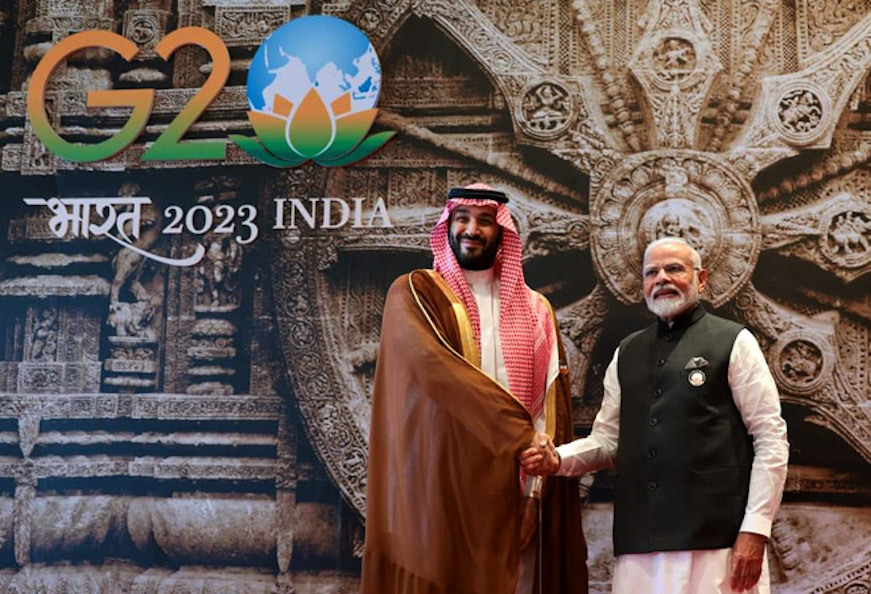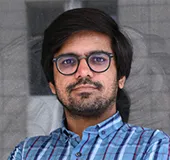-
CENTRES
Progammes & Centres
Location
From the IMEEC to Mohammed bin Salman’s state visit, the week of the G20 Summit in New Delhi saw the assertion of West Asian nations as ‘poles’ of power in a move towards a multipolar order

India’s hosting of the G20 Summit this month culminated in the successful release of a consensus-led ‘Delhi Declaration,’ despite fears that disagreements over Ukraine could lead to a stalemate. With an Indian wish to carry as many voices from the Global South as it could, West Asian (Middle East) representation was in full force with leaders from the United Arab Emirates (UAE), Saudi Arabia, Egypt, Türkiye, and Oman in attendance. Beyond the G20 obligations, Saudi Arabia’s Crown Prince, Mohammed bin Salman (MbS), was also on a state visit. This coincided with the announcement of a India-Middle East-Europe Economic Corridor (IMEEC) along with the United States (US) as a major stakeholder.
The Gulf is arguably where the West versus China competition is most visible today.
While much attention was on India’s ability to salvage the G20’s position in the global multilateral order—as many questioned its relevance over a lack of deliverables on tackling poverty and climate—the representation from West Asia also showcased a rapidly increasing political and financial prominence of the Arab states in the region, The new economic corridor, which naturally got touted as a counter to China’s Belt and Road Initiative (BRI), acted as a potpourri for the common economic interests of the participating states. However, there is much more brewing within the geopolitics and geoeconomics of the Gulf states than what was presented in New Delhi.
The Gulf is arguably where the West versus China competition is most visible today. Events over the past decade, such as the conflict in Yemen, attack on Saudi energy facilities by Houthi militants that are known to have the backing of Tehran, and Western acceptance of the very idea of a nuclearised Iran, accelerated a shift in strategic thinking—one that was already underway. Amidst all this, the Gulf is increasingly seen as a beacon for global economics. While its prowess in hydrocarbons is well known, today, it is also home to 30 percent of overall container trade and 16 percent of all air cargo passage, with a geography that houses less than 6 percent of the global population.
Both the announcement of the IMEEC and visit of MbS increase the reliance of economic security between these two geographies.
The above trends feed into the Gulf’s growing importance, making their voice and partnership invaluable for New Delhi. Both the announcement of the IMEEC and visit of MbS increase the reliance of economic security between these two geographies. The challenge, however, remains an unstable global polity and a movement towards a bi-polar world order instead of a multipolar one that countries like India, Saudi Arabia, and the UAE seek. This challenge will be a defining one for all, with the very definition of globalisation as we have known being contested.
The announcement of the IMEEC connectivity project, currently at a Memorandum of Understanding (MoU) stage, expectedly grabbed headlines as a pound-for-pound answer to China’s BRI initiative. On paper, the economic and political might IMEEC wields is, indeed, impressive as it attempts to bring together countries that can or have a track record of successful collaboration. Perhaps, not surprisingly, despite being geographically distant, excitement from the administration of US President Joe Biden was the most palpable. In New Delhi, where China-led economic designs are today being openly challenged, this enthusiasm will be welcomed.
However, IMEEC will have two realities to it. A geopolitical one, and an economic one. Connectivity projects joining India to West Asia and beyond make sense, nonetheless, successful connectivity projects in general, around the world, remain few and far between. However, much of the analysis on IMEEC since its announcement also misses some crucial points, both on the opportunities and challenges it faces. First, wisdom would be to look at IMEEC as a project that primarily feeds into the diversification of global supply chains and is not only about moving trade from one point to another. This means that it can use the political base set up by the Abraham Accords—which normalised relations between the UAE (along with others like Bahrain) and Israel—and the I2U2, a pre-existing economic initiative between India, Israel, US, and the UAE. This would round up the IMEEC more wholesomely as an umbrella institution truly building new factories for the wider Global South. Its design should also look into feeding manufacturing capacities in places such as Africa and Latin America.
Perhaps, not surprisingly, despite being geographically distant, excitement from the administration of US President Joe Biden was the most palpable.
The challenges for IMEEC are also palpable. To begin with, the idea for the moment is academic at best. History is littered with blueprints of connectivity projects that led nowhere. An intense political push would be needed for the IMEEC to move towards logical conclusions, considering the number of cooks in its kitchen. The two easy capitals to manoeuvre will be Washington, D.C. and New Delhi, both having bipartisan support on a requirement to break Beijing’s hold on global manufacturing and, by association, supply chains. Others in the Gulf, such as Riyadh and Abu Dhabi, come from different thinking. Both are members of China’s BRI initiative, and actively seek Chinese investments. The other factor when it comes to financing IMEEC is a consensus looking towards the US as a primary financial provider. However, the real wealth today lies in sovereign wealth funds in the Gulf itself, thanks to cash rich coffers due to an energy boom and maintenance of high oil prices by OPEC+, which includes Russia. These cash-rich funds look for good investments, and projects like the IMEEC, which can feed into infrastructure expertise and technologies of the West, can make itself available as a good option.
Finally, a lot of the infrastructure to kickstart this initiative is already in place. It is now up to the policy mavens and political powers to offer a consensus-led initiative to the free market as one that is attractive to global business.
MbS’s state visit to India is another moment of diplomacy highlighting the importance of India’s outreach to West Asia over the past decade. For the Saudi heir apparent, India holds an important place. During the height of the Khashoggi crisis, MbS looked towards India, Russia, and China for acceptance. While a bit hesitant, reading the tea leaves of the Saudi monarchy’s succession, India hosted MbS for a flying visit in January 2019 at a time when almost all Western capitals were closed to him. Despite the political risk, this created an opening that may serve New Delhi in the kingdom for decades to come.
The other factor when it comes to financing IMEEC is a consensus looking towards the US as a primary financial provider.
Today, both states chaired the first summit-level meet of the India–Saudi Arabia Strategic Partnership Council, discussing issues such as energy, defence etc. The Saudi 2030 vision, a personal project of MbS’s, opens up opportunity and has been covered widely, showcasing the slow but steady opening up of Saudi society, departing from its infamous conservatism. And these cultural, societal, and ideological changes are perhaps some of the most anticipated globally as an opportunity that has previously never presented itself. Saudi Arabia, known for a long time as home to radical Islamic ideologies such as Wahhabism, is prioritising economic development along with a carefully constructed move towards acceptance of certain liberal ideals. This change is critically important from a global security perspective, without which long-term economic progress for the future, that relies on globalism, would be difficult.
This is something that India also appreciates. Reigning in of extremist ideologies in the Middle East will have a direct impact on similar issues that continue to prevail and thrive in places such as Pakistan, Afghanistan, and other parts of South Asia. A strong India–Saudi partnership, for example, can potentially influence or even pressure radical anti-India elements within the Pakistani political and military ecosystems to reorient their vision of their army and the state. While this may seem far-fetched, the Saudi monarchy’s position as the Custodian of the Two Holy Mosques remains a very powerful one.
The Saudi 2030 vision, a personal project of MbS’s, opens up opportunity and has been covered widely, showcasing the slow but steady opening up of Saudi society, departing from its infamous conservatism.
The geopolitics of West Asia is witnessing tectonic shifts, and countries like Saudi Arabia and the UAE already see themselves as ‘poles’ of power in a move towards a multipolar order. From BRICS+ to SCO and now the G20, the Gulf representation is growing stronger as its economic footprint increases. Challenges, however, remain. While there is a change of season geopolitically, many of the fundamental crisis points remain unresolved—from the Palestine issue to tensions with Iran, from instability in Syria and Iraq to the economic collapse of Lebanon and so on. The trickle-down effect of stability at the top will crucially determine the success of these new economic and political projects in the long term.
The views expressed above belong to the author(s). ORF research and analyses now available on Telegram! Click here to access our curated content — blogs, longforms and interviews.

Kabir Taneja is a Deputy Director and Fellow, Middle East, with the Strategic Studies programme. His research focuses on India’s relations with the Middle East ...
Read More +